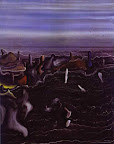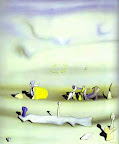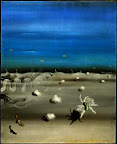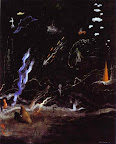Yves Tangui
Raymond Georges Yves Tanguy (January 5, 1900 – January 15, 1955) was a surrealist painter. He was born in Paris, France, the son of a retired navy captain. His parents were both of Breton origin. After his father's death in 1908, his mother moved back to her native Locronan, Finistère, and he ended up spending much of his youth living with various relatives.
In 1918, Yves Tanguy briefly joined the merchant navy before being drafted into the Army, where he befriended Jacques Prévert. At the end of his military service in 1922, he returned to Paris, where he worked various odd jobs. By chance, he stumbled upon a painting by Giorgio de Chirico and was so deeply impressed he resolved to become a painter himself in spite of his complete lack of formal training.
Tanguy had a habit of being completely absorbed by the current painting he was working on. This way of creating artwork might have came about due to his very small studio which could only comfortably have enough room for one wet piece.
Through his friend Jacques Prévert, in around 1924 Tanguy was introduced into the circle of surrealist artists around André Breton. Tanguy quickly began to develop his own unique painting style, giving his first solo exhibition in Paris in 1927, and marrying his first wife later that same year. During this busy time of his life, André Breton gave Tanguy a contract to paint 12 pieces a year. With his fixed income, he painted less and only ended up creating 8 works of art for Breton.
Throughout the 1930s, Tanguy adopted the bohemian lifestyle of the struggling artist with gusto, leading eventually to the failure of his first marriage. In 1938, after seeing the work of fellow artist Kay Sage, Tanguy began a relationship with her that would eventually lead to his second marriage.
With the outbreak of World War II, Sage moved back to her native New York, and Tanguy, judged unfit for military service, followed her. He would spend the rest of his life in the United States. Sage and Tanguy were married in Reno, Nevada on August 17, 1940. Toward the end of the war, the couple moved to Woodbury, Connecticut, converting an old farmhouse into an artists' studio. They spent the rest of their lives there. In 1948, he became a naturalized citizen of the United States.
In January 1955, Tanguy suffered a fatal stroke at Woodbury. His body was cremated and his ashes preserved until Sage's death in 1963. Laster, his ashes were scattered by his friend Pierre Matisse on the beach at Douarnenez in his beloved Brittany, together with those of his wife.
Yves Tanguy's paintings have a unique, immediately recognizable style of nonrepresentational surrealism. They show vast, abstract landscapes, mostly in a tightly limited palette of colors, only occasionally showing flashes of contrasting color accents. Typically, these alien landscapes are populated with various abstract shapes, sometimes angular and sharp as shards of glass, sometimes with an intriguingly organic look to them, like giant amoebae suddenly turned to stone.
Yves Tanguy
From Wikipedia, the free encyclopedia
Yves Tanguy (1900-1955) belongs to the more neglected Surrealists. It was last in 1982, that a retrospective in Baden-Baden was dedicated to his body of work, despite the fact that he was part of the inner circle of Surrealists. The exhibition at the Staatsgalerie Stuttgart with its 80 paintings and 35 works on paper mainly concentrates on the Surrealist landscape. All artistic periods of the artist are covered, from his early Parisian works in 1926/27 to his late work, created in his adopted country, the United States. Some paintings from American museums can be seen for the first time in Europe, among them Le regard d'ambre (1939), La Rapidité des sommeils (1945) and La Rose des quatre vents (1950. Also for the first time since the New York retrospective in the year of Tanguy's death in 1955, two of his last major works, Nombres imaginaires (1954) from the Museo Thyssen-Bornemisza in Madrid and Multiplication des arcs (1954) from the Museum of Modern Art in New York are reunited. Besides works by Tanguy, the Stuttgarter Staatsgalerie also shows exemplary ones by other Surrealists such as de Chirico, Dalí, Ernst, Klee, Masson, Matta, Miró, Paalen, Oelze and Kay Sage, Tanguy's second wife. The Surrealist collective work, Cadavres exquis, rounds up the exhibition. The Staatsgalerie Stuttgart itself owns one of the Metaphysical Compositions by Tanguy from 1935 and, since last year, The Hand in the Clouds from 1927. Tanguy was born in 1900 in Paris as the son of a former captain who was employed in the Maritime Ministry. Yves was a very quiet and at the same time anarchistic man. Allegedly, after having visited a de Chirico exhibition at the Galérie Paul Guillaume in Paris, he spontaneously decided to become a painter. According to more recent research, the encounter with de Chirico's work is dated to the year 1922 (former data ranged from 1923-25). In 1923/24, Tanguy began to draw and paint in watercolors, then influenced by Dadaism, a far cry from his later Pittura metafisica. In 1924, André Breton drew up the Surrealist Manifesto. The autodidact Tanguy only began in the following year to make painting his profession. Thanks to the attention paid to him by Florent Fels who edited the magazine L'Art vivant, he could participate at the Salon de l'Araignée with three drawings. Tanguy's early work shows the influence of German Expressionism, Cubism and Neue Sachlichkeit (New Objectivity). Still in 1925, he turned to Surrealism. In his paintings from the 1920s, he was able to point out the possibilities not only in Surrealism, but of painting in general. Tanguy was in contact with Breton, Aragon, Masson, Magritte, Dalí and Max Ernst, but remained, in the general public's eye at least, in the shadows of the others. Tanguy's form of expression, developed in the mid 1920s, largely remained the same throughout his career, although Karin von Maur demonstrates in her catalogue essay that, in fact, his work shows a greater diversity than expected before. Tanguy combined the Surrealist's principle of guided coincidence with the old master's technique of varnish painting. He remained a follower of André Breton's orthodox Surrealism, not influenced by many others who turned away from Breton. Towards the end of his life, his relationship with his mentor was no longer easy because Breton and Tanguy's second wife Kay Sage hated each other. The first individual exhibition of Tanguy's works at the Galérie Surréaliste in Paris in 1927 showed the autodidact Tanguy at the beginning of his artistic development. Together with André Breton, he invented the titles of his paintings. They came from Charles Richet's Traité de métapsychique, which dealt with parapsychological phenomena. The intention of the titles was to confuse and provoke the observer. Tanguy's search was for the " reality in the unconscious" and for dreams. The exhibition catalogue deals not only with the life and work of Tanguy, but also contains a chronology written by Andreas Schalhorn which pursues the same aims. This is not the place to discuss the painter's life in detail. Just a few words about his last years: in November 1939, after the outbreak of the Second World War, Tanguy emigrated to the United States, where, in 1940, he divorced from his wife Jeannette Ducrocq, whom he had married in 1925. Shortly afterwards, he remarried. His second wife was the American artist Kay Sage whom he had first met in Paris in 1938, when his marriage with his alcoholic wife was already wrecked. Tanguy's paintings were also partly a comment on the arms race and war. In 1948, he became an American citizen. In his last years, he studied the desert landscapes . Tanguy died in 1955 in Woodbury, Connecticut, as the result of a stroke he had suffered from an accident. Already in the years before, his health had steadily declined. In 1963, his widow Kay Sage committed suicide. Both of Tanguy's marriages were childless. |
 |  |  |
 |  |  |  |





Δεν υπάρχουν σχόλια:
Δημοσίευση σχολίου